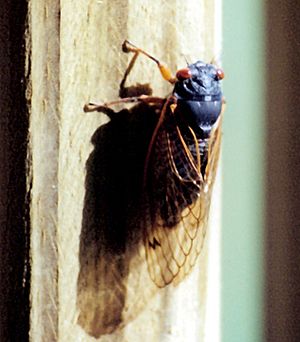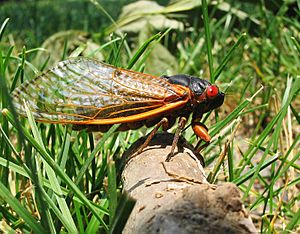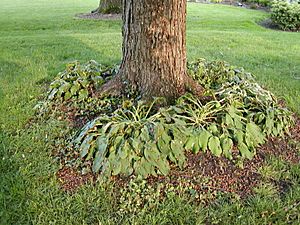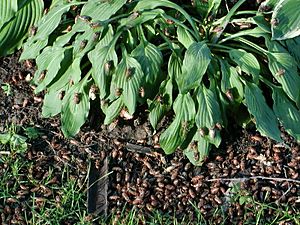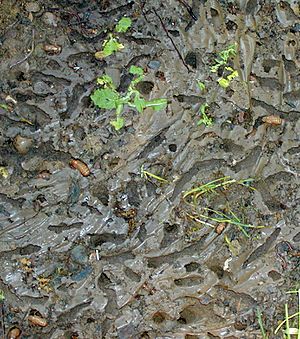Brood X facts for kids
Brood X (also called Brood 10 or the Great Eastern Brood) is one of 15 groups of periodical cicadas that show up regularly in the eastern United States. It covers the largest area and has the most cicadas compared to any other 17-year cicada group.
Every 17 years, millions of Brood X cicadas dig their way out of the ground. They come to the surface to lay their eggs, and then they die within a few weeks. This amazing life cycle helps them survive. They stay hidden underground for a long time. Then, huge numbers of them come out all at once. This short time above ground, before their babies (called nymphs) burrow back down, helps them survive even if many are eaten by other animals.
The last time Brood X appeared was in the spring and early summer of 2004. They were seen in an area that included Illinois, Michigan, New York, and Georgia.
The next time this brood will appear is in the summer of 2021. They are expected to emerge in 15 states. These states are Delaware, Illinois, Georgia, Indiana, New York, Kentucky, Maryland, North Carolina, New Jersey, Ohio, Pennsylvania, Tennessee, Virginia, West Virginia, and Michigan. They will also appear in Washington D.C.. Scientists predict their next big appearance after that will be in 2038. Sometimes, some cicadas from Brood X emerge four years early. This happened in 2000 and again in 2017 in some areas.
Contents
Discovering Brood X's Cycle
People have known about these amazing cicadas for a very long time. Early records show that people noticed their regular appearances centuries ago.
Early Observations
One of the first written descriptions of Brood X coming out was in 1715. A pastor in Philadelphia, Rev. Andreas Sandel, wrote about it in his journal. Later, in 1737, a botanist named John Bartram wrote a letter describing how these cicadas appeared every few years. He had seen them in 1732. Bartram also wrote more details about their emergence in 1749.
Swedish Naturalist's Findings
A Swedish scientist named Pehr Kalm visited Pennsylvania and New Jersey in 1749. He saw Brood X emerge in late May. In a paper he published in 1756, Kalm wrote about the common belief that these insects appeared in huge numbers every seventeen years. He noted that they stayed underground during the years in between.
Kalm found old documents, including one from Benjamin Franklin. These papers showed that large numbers of cicadas had emerged in Pennsylvania in May 1715 and May 1732. People who wrote these documents did not report such large numbers in other years. Kalm also said that people told him they only saw a few cicadas before the huge swarms in 1749. He also noticed that he did not hear many cicadas in 1750 in the same places where he heard many in 1749. All these observations helped prove the idea that the cicadas appeared every seventeen years.
Kalm later summarized his findings in a book published in 1771. He wrote that there are "Locusts" (which is what people sometimes called cicadas) that come out in incredible numbers about every seventeen years. He added that in the years between these big emergences, you only see or hear a few of them in the woods.
More Recent Records
In 1766, Moses Bartram, John Bartram's son, wrote about Brood X. He explained that after the eggs hatched in tree twigs, the young cicadas would go down into the ground. He found them 10 feet (about 3 meters) deep. Others said they found them even deeper, up to 30 feet (about 9 meters) down!
In 1800, Benjamin Banneker, a famous scientist, wrote in his record book. He remembered a "great locust year" in 1749. He saw another big emergence in 1766, which seemed just as large. Then, a third one happened in 1783. Based on this pattern, he correctly predicted that the cicadas would appear again in 1800, seventeen years after their third appearance to him.
Images for kids
-
A Brood X cicada on a growing blackberry fruit near Baltimore (May 22, 2021)
-
Brood X nymphs emerging in Druid Hill Park, Baltimore, Maryland (May 13, 2021)
-
Mud turrets that emerging Brood X cicadas created in Potomac, Maryland near Washington, D.C. (June 30, 2021)
-
A Brood X cicada nymph in Bethesda, Maryland near Washington, D.C. (May 5, 2021)
-
Molting Brood X cicadas on a milkweed plant in Bethesda, Maryland (May 15, 2021)
-
An adult Brood X cicada and exuviae in Columbus, Ohio (May 21, 2021)
-
A Brood X cicada ovipositing eggs in a tree branch near Baltimore, Maryland (May 26, 2021)


